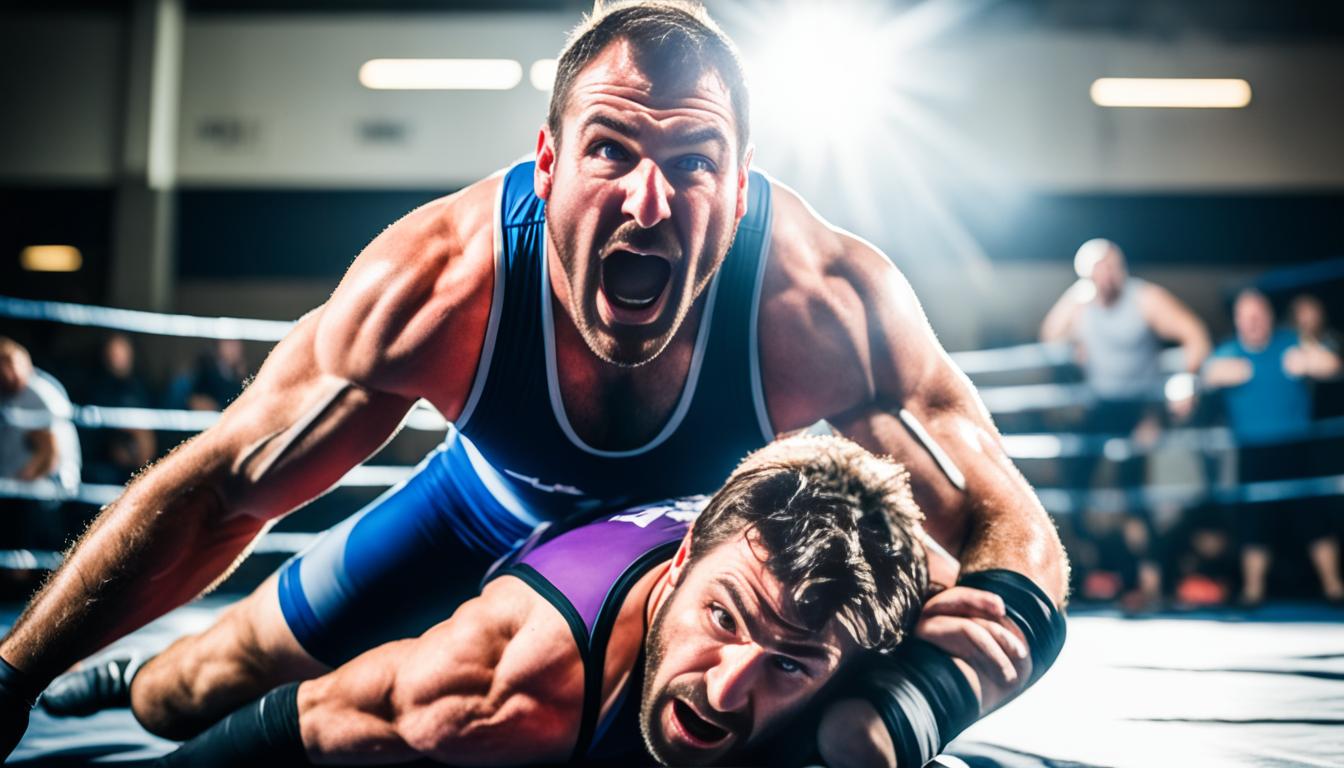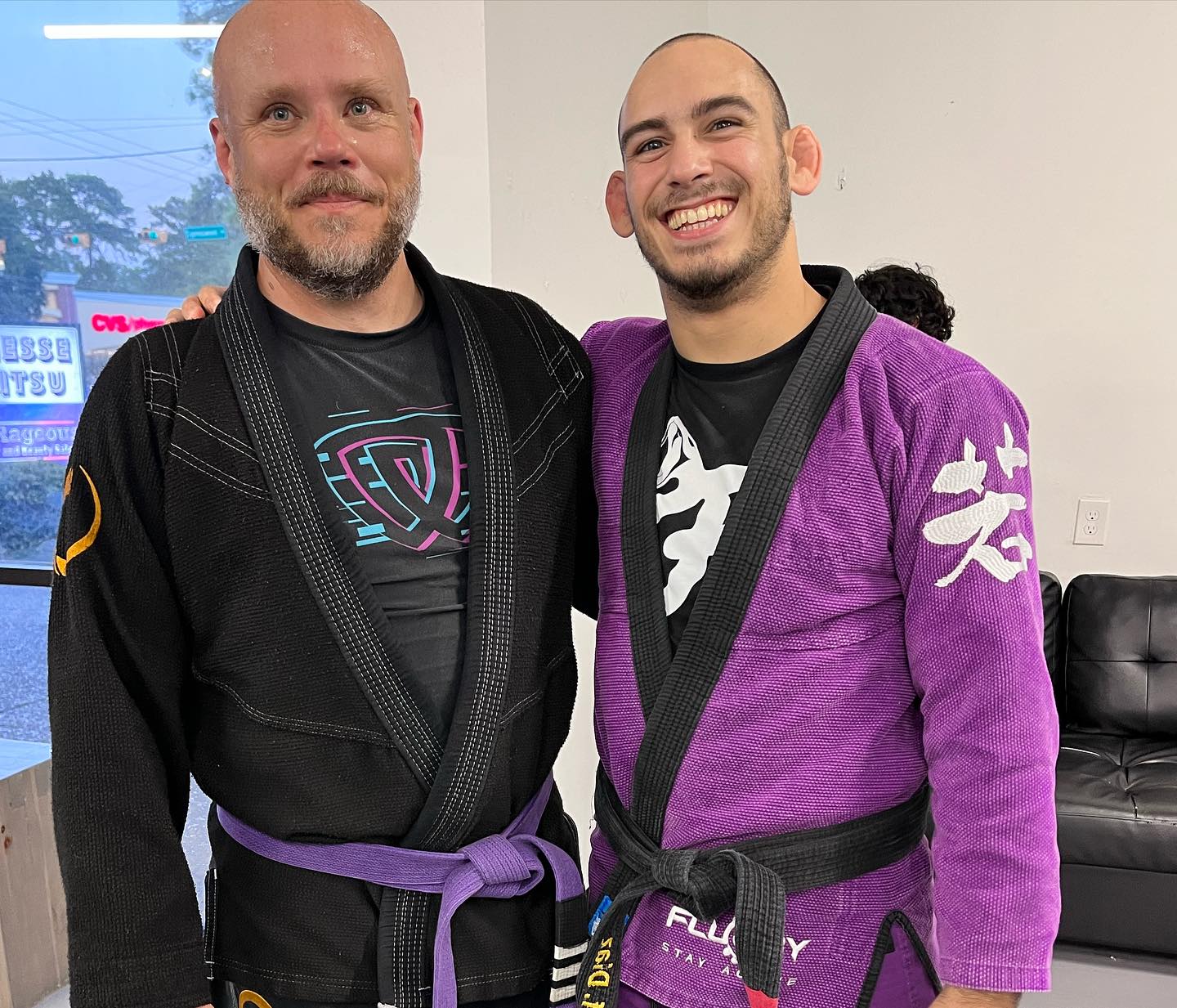by admin
Share
by admin
Share

Did you know over 4.5 million people worldwide practice Brazilian Jiu-Jitsu (BJJ)? This grappling-based martial art is now very popular. It’s a top choice for self-defense and fitness. Starting your BJJ journey can be very rewarding.
This guide will help you start with Brazilian Jiu-Jitsu. We’ll cover the origins, benefits, and how to find the right gym. You’ll also learn how to prepare for your first class and master key techniques.
Key Takeaways
- Brazilian Jiu-Jitsu is a rapidly growing martial art with over 4.5 million practitioners worldwide.
- BJJ emphasizes ground fighting and submission techniques, making it an effective form of self-defense.
- This guide will provide a comprehensive overview of starting your BJJ journey as a beginner.
- Learn about the history, benefits, and essential gear needed to begin your BJJ training.
- Discover how to find the right gym, prepare for your first class, and master the fundamentals of BJJ.
What is Brazilian Jiu-Jitsu (BJJ)?
Brazilian Jiu-Jitsu (BJJ) is a martial art and combat sport that started with the Japanese martial art of Judo. It was developed in the early 1900s. BJJ focuses on grappling, ground fighting, and submission techniques to beat an opponent. The history of Brazilian Jiu Jitsu goes back to Japanese master Mitsuyo Maeda. He taught the Gracie family his grappling skills in Brazil.
The Origins and History of BJJ
The origins of BJJ started in the late 1800s with the Japanese martial art of Judo, created by Jigoro Kano. Mitsuyo Maeda, a student of Kano, went to Brazil and taught his grappling skills to the Gracie family. The Gracies, Carlos and Helio, made these techniques their own. They created Gracie Jiu-Jitsu or Brazilian Jiu-Jitsu.
The Gracie family helped spread BJJ around the world. This made it popular for self-defense and competitions. Now, BJJ is enjoyed by people of all ages and skills, from beginners to top athletes.
The Benefits of Training BJJ
Training Brazilian Jiu-Jitsu has many benefits. It’s a great workout that boosts your heart health, muscle strength, and flexibility. It also helps with mental focus, discipline, and solving problems. Learning to grapple and control others builds confidence and self-defense skills. Plus, the BJJ community offers strong social connections and support.
“Whether your goal is to get in shape, learn self-defense, or challenge yourself in a new martial art, the practice of Brazilian Jiu-Jitsu can deliver transformative results.”
No matter why you’re into BJJ, the benefits of doing BJJ can greatly improve your physical and mental health.
Finding the Right BJJ Gym
Starting your Brazilian Jiu-Jitsu (BJJ) journey means finding the right gym. The right place can change how you learn and grow. When searching for local BJJ gyms, think about what matters most to you. This will help you pick the best gym for you.
Searching for Local BJJ Gyms
Begin by typing “BJJ near me” into Google Maps or your search engine. This will show you the best BJJ gyms close to you. Look for schools with active online profiles. They should have websites and social media that show their classes, schedules, and who teaches them.
After finding gyms, read reviews from students. This will give you a feel for the gym’s vibe and if it fits your goals.
Evaluating the Gym Environment
- Visit gyms in person to feel the training environment. Aim for a place that’s welcoming to everyone, no matter their skill level.
- Watch a class to see how instructors teach and interact with students. Make sure there are beginner-friendly classes and a clear learning path for newbies.
- Check the cleanliness of the facility, the quality of mats and gear, and the staff’s professionalism. These things affect your training a lot.
By looking at these things, you can find the best BJJ gym for you. It should meet your needs and help you reach your goals.
| Factors to Consider When Choosing a BJJ School | Description |
|---|---|
| Location | Close to your home or work, making it easy to go to classes. |
| Instruction Quality | The way instructors teach, their experience, and their qualifications. |
| Training Environment | The feel, cleanliness, and safety of the gym. |
| Class Schedule | Classes that fit your schedule and skill level. |
| Student-Instructor Ratio | The number of students per instructor for better attention. |
“Choosing the right BJJ gym is key for your progress and fun in the sport. Spend time visiting different schools to find one that matches your goals and how you like to train.”
Preparing for Your First BJJ Class
Starting your Brazilian Jiu-Jitsu (BJJ) journey? Knowing what a typical BJJ class is like can make you feel ready and confident. Most classes follow a similar format. This lets you know what to expect and helps you get the most out of your training.
Class Structure and What to Expect
A typical BJJ class starts with a warm-up. This gets your body ready for the training ahead. You’ll do dynamic movements, bodyweight exercises, and light grappling drills. The warm-up raises your heart rate, boosts flexibility, and prepares your muscles for more intense activity.
Next, the instructor will teach you a new BJJ technique. They’ll show you how to do a submission, sweep, or control position. Then, you’ll practice these skills with a partner, putting what you’ve learned into action.
The second part of the class is live sparring, or “rolling.” Here, you’ll use the techniques you’ve learned against an opponent. As a beginner, focus on learning and don’t worry about winning. The goal is to get better and understand BJJ’s details.
“The key to success in Brazilian Jiu-Jitsu is to approach each class with a humble and eager attitude, ready to learn and improve.”
Knowing what a BJJ class is like helps you prepare for your first session. Remember, BJJ is a long and rewarding journey. Embrace the learning process and enjoy the ride.
Essential BJJ Gear and Equipment
Starting your Brazilian Jiu-Jitsu (BJJ) journey means getting the right gear and equipment. Choosing the right BJJ gear for beginners changes your training and comfort on the mats.
The BJJ Gi: Your Essential Uniform
You’ll need a BJJ-specific Gi for traditional training. This uniform is strong, light, and made for the sport. It includes a jacket, pants, and a belt. A good Gi that fits well is key for support and movement during training.
No-Gi Essentials: Rashguards and Shorts
For what to wear for Brazilian Jiu Jitsu in No-Gi, focus on light, snug clothes. A rashguard protects your skin from friction and mat burn. Pair it with spandex or grappling shorts for comfort and movement.
Accessories for Added Protection
- Mouthguard: Protect your teeth and jaw from potential impacts during sparring.
- Athletic Tape: Wrap your fingers and wrists to provide additional support and prevent injuries.
- Gym Bag: A sturdy bag to store and transport your BJJ gear, keeping it organized and clean.
Looking after your BJJ gear for beginners is key. Clean and care for your Gi, rashguards, and other gear to stop infections and keep training safe.
Getting into what to wear for Brazilian Jiu Jitsu might seem hard at first. But, the right gear and equipment are key for your safety, comfort, and fun. As you get better in BJJ, you can add to your gear to fit your needs and likes.
| Essential BJJ Gear | Gi-Based Training | No-Gi Training |
|---|---|---|
| Uniform | BJJ Gi (Jacket, Pants, Belt) | Rashguard, Grappling Shorts |
| Accessories | Mouthguard, Athletic Tape, Gym Bag | Mouthguard, Athletic Tape, Gym Bag |
“Proper gear and equipment are essential for your safety and comfort on the mats. Investing in quality BJJ gear for beginners can greatly enhance your training experience.”
The Cost of Training Brazilian Jiu-Jitsu for Beginners
Starting your Brazilian Jiu-Jitsu (BJJ) journey is thrilling, but knowing the costs is key. The price depends on where you are, the gym you pick, and how often you train.
You can expect to pay $100 to $200 per month for a regular BJJ membership. This gets you unlimited group classes. You’ll learn with others and improve your skills together.
Some gyms charge extra for private lessons, seminars, or events. These costs can increase your total BJJ expenses. So, think about all the costs when choosing a gym.
When picking a BJJ gym, look at more than just monthly fees. You might also need to pay a start-up fee or buy a uniform, known as a “gi”.
BJJ might not be cheap, but its long-term benefits make it a good investment for many.
The cost of BJJ training varies, but with research and planning, you can find a gym that suits your budget. It will offer quality instruction and a great training space.
Understanding the BJJ Belt System
BJJ’s belt system is key to the martial art. It tracks a practitioner’s progress and skill level. Knowing the belt system and how to earn them is vital on your BJJ journey.
The belt system ranges from white to black. Each belt takes years of training and mastering techniques. The IBJJF sets time requirements to advance, aiming for black belt in about 10 years.
As you move up the ranks, you learn more about the art. You’ll get better at techniques and strategy. Each belt marks a new skill level and deeper understanding of BJJ.
| Belt Rank | Time to Achieve | Skill Level |
|---|---|---|
| White Belt | Beginner | Introductory level, learning the fundamentals of BJJ |
| Blue Belt | 2-3 years | Intermediate level, demonstrating a solid grasp of techniques and strategies |
| Purple Belt | 4-5 years | Advanced level, exhibiting a high level of technical proficiency and strategic thinking |
| Brown Belt | 6-7 years | Experienced level, approaching the level of a black belt with exceptional skills |
| Black Belt | Approximately 10 years | Expert level, mastery of BJJ techniques and principles, often becoming an instructor |
Getting each BJJ belt is a big deal. It shows your hard work, discipline, and love for the art. As you go up the ranks, you’ll get better physically and mentally. You’ll become a well-rounded practitioner.
“The path to the black belt is not a sprint, but a marathon. Embrace the journey, celebrate small victories, and enjoy the process of becoming a better grappler.”
Brazilian Jiu-Jitsu for Beginners: Positions and Guards
In Brazilian Jiu-Jitsu (BJJ), understanding “positions” is key. The sport has a hierarchy of BJJ positions, from top spots like the back mount to bottom spots like the closed guard. Learning these positions and how to move between them is vital for skill growth.
The Hierarchy of Positions
The top player in BJJ aims to keep control and move to stronger positions. The bottom player tries to sweep, submit, or escape to a better spot. Knowing the positions in Brazilian Jiu Jitsu hierarchy is crucial for skill and success.
Mastering the Closed and Open Guards
The guard is a key part of BJJ, letting the bottom player control and launch attacks. The closed guard locks the legs around the opponent, offering a strong base for attacks like the armbar and triangle choke. The open guard uses the legs for offense, controlling distance and setting up sweeps. Learning both guards is key for beginners to improve their BJJ skills.
“The guard is a core concept in BJJ, as it allows the practitioner on the bottom to control the position and initiate attacks.”
BJJ Techniques for Beginners
As a beginner in Brazilian Jiu-Jitsu (BJJ), it’s key to learn the basic techniques and submissions. You’ll start with the armbar, triangle choke, and kimura. These moves use leverage and joint control to beat your opponent.
You’ll also learn various chokes like the rear-naked choke and guillotine choke. These chokes cut off blood or air flow, making it hard for your opponent to stay awake.
Basic Submissions and Chokes
- Armbar: This submission targets the elbow joint, using your legs to stretch and press on the arm.
- Triangle Choke: A strong choke that traps the opponent’s head and arm, stopping blood flow.
- Kimura: This move twists the arm, putting a lot of pressure on the shoulder joint.
- Rear-Naked Choke: A classic choke that blocks blood flow to the brain, making the opponent pass out.
- Guillotine Choke: A choke that squeezes the neck, cutting off the opponent’s air.
Learning these BJJ submissions for beginners and basic chokes in Brazilian Jiu Jitsu lays a strong base for your BJJ skills. With regular practice and a focus on doing things right, you’ll get better at these key moves.
“The key to success in Brazilian Jiu-Jitsu is to focus on the basics and perfect the fundamentals.”
Etiquette and Attitude on the Mats
Practicing Brazilian Jiu-Jitsu (BJJ) is more than just learning moves and sparring. It’s about being respectful and humble, and following certain etiquette rules. It’s key to have good BJJ etiquette for a positive training space for everyone.
Call your instructor “professor,” even if they’re not a black belt. This shows you respect their knowledge and role in BJJ. Also, keep your BJJ gi and gear clean and in good shape. Cleanliness is important on the mats.
- Address black belt instructors as “professor”
- Keep your gi and equipment clean and well-maintained
- Avoid overly aggressive or dangerous behavior during sparring
- Respect the tapping (submission) of your training partner
- Be open to learning from everyone, regardless of rank or experience level
Be careful not to be too aggressive or risky in sparring. Always respect when your partner taps, meaning they’ve had enough. Also, be open to learning from anyone, no matter their rank or experience. There’s always something new to learn in Brazilian Jiu-Jitsu.
“The true martial artist has a humble, open, and respectful attitude on the mats. This is the foundation of proper behavior in Brazilian Jiu Jitsu.”
Following these BJJ etiquette rules helps make a positive training space for you and others. It also adds to the Brazilian Jiu-Jitsu community’s culture.
| Key Aspects of BJJ Etiquette | Importance |
|---|---|
| Addressing Instructors as “Professor” | Shows respect for their expertise and position within the BJJ community |
| Maintaining Cleanliness of Gi and Equipment | Good hygiene is essential on the mats |
| Avoiding Aggressive or Dangerous Behavior | Ensures the safety of all practitioners and fosters a positive training environment |
| Respecting Tapping (Submission) | Demonstrates understanding of one’s own and others’ limits |
| Being Open to Learning from All Practitioners | Promotes a humble and open-minded attitude, essential for growth in BJJ |
Surviving Your First Few Months of BJJ
Starting your journey in Brazilian Jiu-Jitsu (BJJ) is exciting and tough. As a beginner, focus on preventing injuries and setting realistic goals. This will help you smoothly enter this dynamic martial art.
Injury Prevention Tips
Keeping safe from injuries is crucial in the first few months of BJJ training. Start by listening to your body and not pushing too hard. Slowly increase your training intensity and time to let your body adjust.
Always warm up well and focus on proper technique to lower the chance of joint injuries. Using protective gear like a mouthguard and athletic tape can also help with minor injuries. Staying hydrated, resting enough, and doing other exercises can keep you healthy and injury-free in your BJJ journey.
Managing Expectations
When starting Brazilian Jiu-Jitsu, it’s key to manage your expectations and enjoy the learning process. You’ll feel overwhelmed and frustrated at times, as it takes time and effort to master the art. Don’t compare yourself to others, and set realistic goals like learning a new move or improving balance.
Remember, regular training is more important than how hard you train. Approach each class with an open mind, ready to make mistakes, and a commitment to getting better. This will help you see progress in your BJJ skills.
“The journey of a thousand miles begins with a single step.” – Lao Tzu
Remember, how to avoid injuries in BJJ and setting realistic goals in Brazilian Jiu Jitsu are key for beginners. By focusing on preventing injuries and managing your goals, you’ll do well in your BJJ journey.
Conclusion
Starting Brazilian Jiu-Jitsu can feel exciting and a bit scary, but with the right mindset and help, you’re set to enjoy its many benefits. It helps you learn self-defense, boosts your fitness, and builds a strong community. Plus, it helps you grow personally.
Choosing the right starting Brazilian Jiu Jitsu gym and getting ready for your first class is key. Embrace the learning process, and you’ll be ready to master the “gentle art” of Brazilian Jiu-Jitsu. Remember, being consistent and patient is important. With hard work, you’ll reach new heights on the mats.
Whether you’re new to beginning BJJ or you’ve been doing it for a while, the journey is always about growing, facing new challenges, and finding yourself. Embrace the journey, trust your teachers, and enjoy the adventure as you start this martial arts path.
FAQ
What is Brazilian Jiu-Jitsu (BJJ)?
What are the benefits of training Brazilian Jiu-Jitsu?
How do I find the right Brazilian Jiu-Jitsu gym?
What can I expect during my first Brazilian Jiu-Jitsu class?
What kind of gear and equipment do I need for Brazilian Jiu-Jitsu?
How much does it cost to train Brazilian Jiu-Jitsu?
How does the Brazilian Jiu-Jitsu belt system work?
What are the fundamental positions and guards in Brazilian Jiu-Jitsu?
What are some of the basic submissions and chokes in Brazilian Jiu-Jitsu?
What is the etiquette and attitude expected on the Brazilian Jiu-Jitsu mats?
How can I prevent injuries as a beginner in Brazilian Jiu-Jitsu?
What should I expect as a beginner in Brazilian Jiu-Jitsu?
STAY IN THE LOOP
Subscribe to our free newsletter.
Discover why Brazilian Jiu Jitsu is the perfect Family Martial Arts activity. Learn how it promotes bonding, fitness, and self-defense skills for all ages and abilities.
Discover top-rated BJJ gyms in your area with our comprehensive guide. Find expert instruction, flexible schedules, and a supportive community for BJJ Near Me.
Discover the benefits of Adult Wrestling Spring TX. Learn how this challenging sport improves fitness, builds confidence, and fosters community for adults of all ages.
Discover why Brazilian Jiu Jitsu Spring is gaining traction. Learn about its benefits, top academies, and how it's transforming lives in our community.




